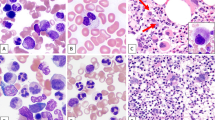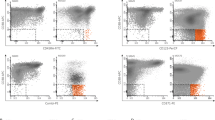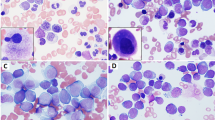Abstract
Adult acute myeloid leukemia (AML) is a highly heterogeneous stem cell malignancy characterized by the clonal expansion of immature myeloid precursors. AML may emerge de novo, following other hematopoietic malignancies or after cytotoxic therapy for other disorders. Here, we investigated the clonal vs reactive nature of residual maturing bone marrow cells in 59 newly diagnosed adult AML and mixed phenotype acute leukemia (MPAL) patients as assessed by interphase fluorescence in situ hybridization analysis of AML and myelodysplastic syndrome-associated cytogenetic alterations and/or the pattern of chromosome X inactivation, in females. In addition, we investigated the potential association between the degree of molecular/genetic involvement of hematopoiesis and coexistence of altered immunophenotypes by flow cytometry. Our results indicate that residual maturing neutrophils, monocytes and nucleated red cell precursors from the great majority of newly diagnosed AML and MPAL cases show a clonal pattern of involvement of residual maturing hematopoietic cells, in association with a greater number of altered immunophenotypes. These findings are consistent with the replacement of normal/reactive hematopoiesis by clonal myelopoiesis and/or erythropoiesis in most newly diagnosed AML and MPAL cases, supporting the notion that in most adults presenting with de novo AML, accumulation of blast cells could occur over a pre-existing clonal hematopoiesis.
This is a preview of subscription content, access via your institution
Access options
Subscribe to this journal
Receive 12 print issues and online access
$259.00 per year
only $21.58 per issue
Buy this article
- Purchase on Springer Link
- Instant access to full article PDF
Prices may be subject to local taxes which are calculated during checkout

Similar content being viewed by others
References
Arber DA, Brunning RD, Vardiman JW, Le Beau MM, Orazi A, Bain BJ et al. Acute myeloid leukaemia and related precursor neoplasms. In: Swerdlow SH et al (eds) WHO Classification of Tumours and Haematopoietic and Lymphoid Tissues. IARC: Lyon, 2008; pp 106–145.
Mrozek K, Bloomfield CD . Chromosome aberrations, gene mutations and expression changes, and prognosis in adult acute myeloid leukemia. ASH Education Book 2006; 2006: 167–177.
Mrozek K, Marcucci G, Paschka P, Whitman SP, Bloomfield CD . Clinical relevance of mutations and gene-expression changes in adult acute myeloid leukemia with normal cytogenetics: are we ready for a prognostically prioritized molecular classification? Blood 2007; 109: 431–448.
Larson RA . Is secondary leukemia an independent poor prognostic factor in acute myeloid leukemia? Best Pract Res Clin Haematol 2007; 20: 29–37.
Arber DA, Stein AS, Carter NH, Ikle D, Forman SJ, Slovak ML . Prognostic impact of acute myeloid leukemia classification. Importance of detection of recurring cytogenetic abnormalities and multilineage dysplasia on survival. Am J Clin Pathol 2003; 119: 672–680.
Mrozek K, Dohner H, Bloomfield CD . Influence of new molecular prognostic markers in patients with karyotypically normal acute myeloid leukemia: recent advances. Curr Opin Hematol 2007; 14: 106–114.
Radmacher MD, Marcucci G, Ruppert AS, Mrozek K, Whitman SP, Vardiman JW et al. Independent confirmation of a prognostic gene-expression signature in adult acute myeloid leukemia with a normal karyotype: a Cancer and Leukemia Group B study. Blood 2006; 108: 1677–1683.
Kopp P, Jaggi R, Tobler A, Borisch B, Oestreicher M, Sabacan L et al. Clonal X-inactivation analysis of human tumours using the human androgen receptor gene (HUMARA) polymorphism: a non-radioactive and semiquantitative strategy applicable to fresh and archival tissue. Mol Cell Probes 1997; 11: 217–228.
Matarraz S, Lopez A, Barrena S, Fernandez C, Jensen E, Flores J et al. The immunophenotype of different immature, myeloid and B-cell lineage-committed CD34+ hematopoietic cells allows discrimination between normal/reactive and myelodysplastic syndrome precursors. Leukemia 2008; 22: 1175–1183.
Matarraz S, Lopez A, Barrena S, Fernandez C, Jensen E, Flores-Montero J et al. Bone marrow cells from myelodysplastic syndromes show altered immunophenotypic profiles that may contribute to the diagnosis and prognostic stratification of the disease: a pilot study on a series of 56 patients. Cytometry B Clin Cytom 2010; 78: 154–168.
Kalina T, Flores-Montero J, van der Velden VH, Martin-Ayuso M, Bottcher S, Ritgen M et al. EuroFlow standardization of flow cytometer instrument settings and immunophenotyping protocols. Leukemia 2012; 26: 1986–2010.
van Dongen JJ, Lhermitte L, Bottcher S, Almeida J, van der Velden VH, Flores-Montero J et al. EuroFlow antibody panels for standardized n-dimensional flow cytometric immunophenotyping of normal, reactive and malignant leukocytes. Leukemia 2012; 26: 1908–1975.
Rasillo A, Tabernero MD, Sanchez ML, Perez de Andres M, Martin Ayuso M, Hernandez J et al. Fluorescence in situ hybridization analysis of aneuploidization patterns in monoclonal gammopathy of undetermined significance versus multiple myeloma and plasma cell leukemia. Cancer 2003; 97: 601–609.
Gale RE, Mein CA, Linch DC . Quantification of X-chromosome inactivation patterns in haematological samples using the DNA PCR-based HUMARA assay. Leukemia 1996; 10: 362–367.
Nakahara Y, Suzuki H, Ohashi H, Hatano S, Tomita A, Kinoshita T et al. Clonality analysis of granulocytes and T lymphocytes in healthy females by the PCR-based HUMARA method. Int J Hematol 1999; 69: 237–243.
Uchida T, Ohashi H, Aoki E, Nakahara Y, Hotta T, Murate T et al. Clonality analysis by methylation-specific PCR for the human androgen-receptor gene (HUMARA-MSP). Leukemia 2000; 14: 207–212.
Sotlar K, Escribano L, Landt O, Mohrle S, Herrero S, Torrelo A et al. One-step detection of c-kit point mutations using peptide nucleic acid-mediated polymerase chain reaction clamping and hybridization probes. Am J Pathol 2003; 162: 737–746.
Garcia-Montero AC, Jara-Acevedo M, Teodosio C, Sanchez ML, Nunez R, Prados A et al. KIT mutation in mast cells and other bone marrow hematopoietic cell lineages in systemic mast cell disorders: a prospective study of the Spanish Network on Mastocytosis (REMA) in a series of 113 patients. Blood 2006; 108: 2366–2372.
Westers TM, Ireland R, Kern W, Alhan C, Balleisen JS, Bettelheim P et al. Standardization of flow cytometry in myelodysplastic syndromes: a report from an international consortium and the European LeukemiaNet Working Group. Leukemia 2012; 26: 1730–1741.
Craig FE, Foon KA . Flow cytometric immunophenotyping for hematologic neoplasms. Blood 2008; 111: 3941–3967.
Della Porta MG, Picone C, Pascutto C, Malcovati L, Tamura H, Handa H et al. Multicenter validation of a reproducible flow cytometric score for the diagnosis of low-grade myelodysplastic syndromes: results of a European LeukemiaNET study. Haematologica 2012; 97: 1209–1217.
van de Loosdrecht AA, Ireland R, Kern W, Della Porta MG, Alhan C, Balleisen JS et al. Rationale for the clinical application of flow cytometry in patients with myelodysplastic syndromes: position paper of an International Consortium and the European LeukemiaNet Working Group. Leuk Lymphoma 2012; 54: 472–475.
Gahn B, Haase D, Unterhalt M, Drescher M, Schoch C, Fonatsch C et al. De novo AML with dysplastic hematopoiesis: cytogenetic and prognostic significance. Leukemia 1996; 10: 946–951.
Lowenberg B . Diagnosis and prognosis in acute myeloid leukemia—the art of distinction. N Engl J Med 2008; 358: 1960–1962.
Baldus CD, Mrozek K, Marcucci G, Bloomfield CD . Clinical outcome of de novo acute myeloid leukaemia patients with normal cytogenetics is affected by molecular genetic alterations: a concise review. Br J Haematol 2007; 137: 387–400.
Ohyashiki JH, Ohyashiki K, Kawakubo K, Fujimura T, Shimamoto T, Nakazawa S et al. Comparison between immunogenotypic findings in de novo AML and AML post MDS. Leukemia 1993; 7: 1747–1751.
Pagano L, Mele L, Fianchi L, Rutella S, Piscitelli R, Leone G et al. Immunophenotypic analysis in 119 patients with acute myeloid leukemia following a previous malignancy: a comparison with the immunophenotype of 231 de novo AML. Haematologica 2003; 88: 225–227.
Ostgard LS, Kjeldsen E, Holm MS, Brown Pde N, Pedersen BB, Bendix K et al. Reasons for treating secondary AML as de novo AML. Eur J Haematol 2010; 85: 217–226.
Preiss BS, Bergmann OJ, Friis LS, Sorensen AG, Frederiksen M, Gadeberg OV et al. Cytogenetic findings in adult secondary acute myeloid leukemia (AML): frequency of favorable and adverse chromosomal aberrations do not differ from adult de novo AML. Cancer Genet Cytogenet 2010; 202: 108–122.
Lowenberg B, Downing JR, Burnett A . Acute myeloid leukemia. N Engl J Med 1999; 341: 1051–1062.
Tefferi A, Thiele J, Vardiman JW . The 2008 World Health Organization classification system for myeloproliferative neoplasms: order out of chaos. Cancer 2009; 115: 3842–3847.
Milosevic JD, Puda A, Malcovati L, Berg T, Hofbauer M, Stukalov A et al. Clinical significance of genetic aberrations in secondary acute myeloid leukemia. Am J Hematol 2012; 87: 1010–1016.
Estey E, Dohner H . Acute myeloid leukaemia. Lancet 2006; 368: 1894–1907.
Arber DA, Slovak ML, Popplewell L, Bedell V, Ikle D, Rowley JD . Therapy-related acute myeloid leukemia/myelodysplasia with balanced 21q22 translocations. Am J Clin Pathol 2002; 117: 306–313.
Mauritzson N, Albin M, Rylander L, Billstrom R, Ahlgren T, Mikoczy Z et al. Pooled analysis of clinical and cytogenetic features in treatment-related and de novo adult acute myeloid leukemia and myelodysplastic syndromes based on a consecutive series of 761 patients analyzed 1976-1993 and on 5098 unselected cases reported in the literature 1974-2001. Leukemia 2002; 16: 2366–2378.
Leone G, Mele L, Pulsoni A, Equitani F, Pagano L . The incidence of secondary leukemias. Haematologica 1999; 84: 937–945.
Leith CP, Kopecky KJ, Godwin J, McConnell T, Slovak ML, Chen IM et al. Acute myeloid leukemia in the elderly: assessment of multidrug resistance (MDR1) and cytogenetics distinguishes biologic subgroups with remarkably distinct responses to standard chemotherapy. A Southwest Oncology Group study. Blood 1997; 89: 3323–3329.
Miyazaki Y, Kuriyama K, Miyawaki S, Ohtake S, Sakamaki H, Matsuo T et al. Cytogenetic heterogeneity of acute myeloid leukaemia (AML) with trilineage dysplasia: Japan Adult Leukaemia Study Group-AML 92 study. Br J Haematol 2003; 120: 56–62.
Yanada M, Suzuki M, Kawashima K, Kiyoi H, Kinoshita T, Emi N et al. Long-term outcomes for unselected patients with acute myeloid leukemia categorized according to the World Health Organization classification: a single-center experience. Eur J Haematol 2005; 74: 418–423.
Miesner M, Haferlach C, Bacher U, Weiss T, Macijewski K, Kohlmann A et al. Multilineage dysplasia (MLD) in acute myeloid leukemia (AML) correlates with MDS-related cytogenetic abnormalities and a prior history of MDS or MDS/MPN but has no independent prognostic relevance: a comparison of 408 cases classified as "AML not otherwise specified" (AML-NOS) or "AML with myelodysplasia-related changes" (AML-MRC). Blood 2010; 116: 2742–2751.
Grimwade D, Walker H, Oliver F, Wheatley K, Harrison C, Harrison G et al. The importance of diagnostic cytogenetics on outcome in AML: analysis of 1612 patients entered into the MRC AML 10 trial. The Medical Research Council Adult and Children's Leukaemia Working Parties. Blood 1998; 92: 2322–2333.
Byrd JC, Mrozek K, Dodge RK, Carroll AJ, Edwards CG, Arthur DC et al. Pretreatment cytogenetic abnormalities are predictive of induction success, cumulative incidence of relapse, and overall survival in adult patients with de novo acute myeloid leukemia: results from Cancer and Leukemia Group B (CALGB 8461). Blood 2002; 100: 4325–4336.
Grimwade D, Hills RK, Moorman AV, Walker H, Chatters S, Goldstone AH et al. Refinement of cytogenetic classification in acute myeloid leukemia: determination of prognostic significance of rare recurring chromosomal abnormalities among 5876 younger adult patients treated in the United Kingdom Medical Research Council trials. Blood 2010; 116: 354–365.
Marlton P, Keating M, Kantarjian H, Pierce S, O'Brien S, Freireich EJ et al. Cytogenetic and clinical correlates in AML patients with abnormalities of chromosome 16. Leukemia 1995; 9: 965–971.
Claxton DF, Marlton P, Siciliano MJ . Molecular genetics of inversion 16 leukemia: implications for leukemogenesis. Cancer Treat Res 1996; 84: 1–18.
Speck NA, Gilliland DG . Core-binding factors in haematopoiesis and leukaemia. Nat Rev Cancer 2002; 2: 502–513.
Chen Z, Morgan R, Berger CS, Pearce-Birge L, Stone JF, Sandberg AA . Identification of masked and variant Ph (complex type) translocations in CML and classic Ph in AML and ALL by fluorescence in situ hybridization with the use of bcr/abl cosmid probes. Cancer Genet Cytogenet 1993; 70: 103–107.
Hamaguchi H, Suzukawa K, Nagata K, Yamamoto K, Yagasaki F, Morishita K . Establishment of a novel human myeloid leukaemia cell line (HNT-34) with t(3;3)(q21;q26), t(9;22)(q34;q11) and the expression of EVI1 gene, P210 and P190 BCR/ABL chimaeric transcripts from a patient with AML after MDS with 3q21q26 syndrome. Br J Haematol 1997; 98: 399–407.
Tefferi A, Vardiman JW . The diagnostic interface between histology and molecular tests in myeloproliferative disorders. Curr Opin Hematol 2007; 14: 115–122.
Yang Y, Huang Q, Lu Y, Li X, Huang S . Reactivating PP2A by FTY720 as a novel therapy for AML with C-KIT tyrosine kinase domain mutation. J Cell Biochem 2012; 113: 1314–1322.
Appelbaum FR, Kopecky KJ, Tallman MS, Slovak ML, Gundacker HM, Kim HT et al. The clinical spectrum of adult acute myeloid leukaemia associated with core binding factor translocations. Br J Haematol 2006; 135: 165–173.
Walter MJ, Shen D, Ding L, Shao J, Koboldt DC, Chen K et al. Clonal architecture of secondary acute myeloid leukemia. N Engl J Med 2012; 366: 1090–1098.
Mrozek K, Heerema NA, Bloomfield CD . Cytogenetics in acute leukemia. Blood Rev 2004; 18: 115–136.
Greenberg P, Cox C, LeBeau MM, Fenaux P, Morel P, Sanz G et al. International scoring system for evaluating prognosis in myelodysplastic syndromes. Blood 1997; 89: 2079–2088.
Bernell P, Arvidsson I, Hast R, Jacobsson B, Stenke L . Differences in cell lineage involvement between MDS-AML and de novo AML studied by fluorescence in situ hybridization in combination with morphology. Eur J Haematol 1997; 58: 241–245.
Preisler HD . Evolution of secondary hematologic disorders: preMDS—>MDS—>sAML. Cancer Treat Res 2001; 108: 185–230.
Kelly L, Clark J, Gilliland DG . Comprehensive genotypic analysis of leukemia: clinical and therapeutic implications. Curr Opin Oncol 2002; 14: 10–18.
Kelly LM, Gilliland DG . Genetics of myeloid leukemias. Annu Rev Genomics Hum Genet 2002; 3: 179–198.
Vardiman JW, Thiele J, Arber DA, Brunning RD, Borowitz MJ, Porwit A et al. The 2008 revision of the World Health Organization (WHO) classification of myeloid neoplasms and acute leukemia: rationale and important changes. Blood 2009; 114: 937–951.
Dicker F, Haferlach C, Sundermann J, Wendland N, Weiss T, Kern W et al. Mutation analysis for RUNX1, MLL-PTD, FLT3-ITD, NPM1 and NRAS in 269 patients with MDS or secondary AML. Leukemia 2010; 24: 1528–1532.
Acknowledgements
This work was supported by grants from the Fondo de Investigaciones Sanitarias (FIS) of the Ministerio de Economía y Competitividad, Madrid, Spain (RETICS RD12/0036/0048-FEDER); Junta de Castilla y León (Ayuda al Grupo GR37 de Excelencia de Castilla y León). CFG was supported by a grant from the Fondo de Investigaciones Sanitarias (FIS) of the Ministerio de Economía y Competitividad, Madrid, Spain (PI08/90881). MCS-S was supported by a grant from Coordenação de Aperfeiçoamento de Pessoal de Nível Superior -CAPES (1386/06-9) do Ministério de Educação do Brasil.
Author information
Authors and Affiliations
Corresponding author
Additional information
Supplementary Information accompanies this paper on the Leukemia website
Supplementary information
Rights and permissions
About this article
Cite this article
Fernandez, C., Santos-Silva, M., López, A. et al. Newly diagnosed adult AML and MPAL patients frequently show clonal residual hematopoiesis. Leukemia 27, 2149–2156 (2013). https://doi.org/10.1038/leu.2013.109
Received:
Revised:
Accepted:
Published:
Issue Date:
DOI: https://doi.org/10.1038/leu.2013.109
Keywords
This article is cited by
-
Phenotypic identification of subclones in multiple myeloma with different chemoresistant, cytogenetic and clonogenic potential
Leukemia (2015)
-
Origins of aberrant DNA methylation in acute myeloid leukemia
Leukemia (2014)
-
Immunophenotypic alterations of bone marrow myeloid cell compartments in multiple myeloma patients predict for myelodysplasia-associated cytogenetic alterations
Leukemia (2014)



